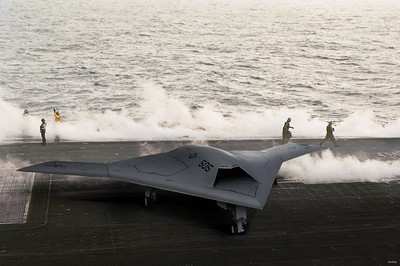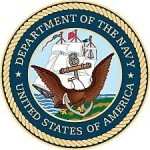First Unmanned Jet Aircraft To Take Off And Land Aboard An
Aircraft Carrier
Personnel from the Navy Unmanned Combat Air System (N-UCAS)
program team and industry partner Northrop Grumman Corporation are
underway with USS Abraham Lincoln (CVN 72) to test the integration
of existing ship systems with new systems that will support the
X-47B Unmanned Combat Air System Demonstration (UCAS-D). The effort
will reduce program risk and is one of many steps toward the
X-47B's first carrier "trap."

The X-47B will be the first unmanned jet aircraft to take off
and land aboard an aircraft carrier. With a 62ft wingspan and
length of 38ft, the X-47B is about 87 percent the size of the
F/A-18C aircraft currently operating aboard Navy aircraft
carriers.
The UCAS-D effort is focused on developing and demonstrating an
aircraft carrier (CV) suitable, low observable (LO) unmanned air
system in support of persistent, penetrating surveillance, and
penetrating strike capabilities in high threat areas. The effort
will evolve technologies required to conduct launch, recovery, and
carrier controlled airspace (CCA) operations and autonomous air
refueling (AAR) of an LO platform. By FY13, the Navy plans to
achieve UCAS CV demonstration; achieve hybrid probe & drogue
(USN style) and boom/receptacle (USAF style) AAR demonstration; and
evaluate and identify technologies supporting future naval
capability requirements.
Mark Pilling, a former naval flight officer with operational
unmanned aircraft experience, is the team's mission operator. He
and his team are charged with verifying mission operator software
between the ship and aircraft. "This is the first step in the
X-47B's integration into the carrier's systems," said Pilling.
 The team is testing X-47B software integration by using a King
Air turbo prop "surrogate" aircraft taking off and landing from
shore. As the aircraft approaches the carrier, it performs the same
types of procedures as manned aircraft. However, since the X-47B is
unmanned, digital messages from shipboard controllers will be used
to control the aircraft instead of verbal instructions. In response
to the digital command and control messages, the plane's software
confirms, complies and sends a "wilco" signal back to the
controllers and mission operator. "Over the last two at sea periods
on Lincoln, we have integrated into a number of the ship systems,
from PriFly, to CATCC, to the LSO platform," said Pilling.
The team is testing X-47B software integration by using a King
Air turbo prop "surrogate" aircraft taking off and landing from
shore. As the aircraft approaches the carrier, it performs the same
types of procedures as manned aircraft. However, since the X-47B is
unmanned, digital messages from shipboard controllers will be used
to control the aircraft instead of verbal instructions. In response
to the digital command and control messages, the plane's software
confirms, complies and sends a "wilco" signal back to the
controllers and mission operator. "Over the last two at sea periods
on Lincoln, we have integrated into a number of the ship systems,
from PriFly, to CATCC, to the LSO platform," said Pilling.
Janice Stolzy, the Northrop Grumman project lead, is on board to
verify that the prototype equipment works in a real-time
operational environment. Stolzy said successful UCAS-D system
testing on Lincoln will set the stage for additional developmental
testing later this year, including testing the software integration
using an F/A-18 surrogate aircraft to more closely emulate the
X-47B's flight path.
John Zander, Naval Air Systems Command (NAVAIR) lead test
engineer, said a prime benefit of a UCAS concept is to reduce the
risk to human pilots. "This is an important milestone for the Navy
and we're making great strides on board Lincoln," said Zander.
Additional UCAS-D development activities are underway at
multiple NAVAIR and Northrop Grumman sites throughout the United
States. First flight of the X-47B is expected later this year.
 Airborne 05.19.25: Kolb v Tornados, Philippine Mars, Blackhawk Antler Theft
Airborne 05.19.25: Kolb v Tornados, Philippine Mars, Blackhawk Antler Theft Airborne 05.23.25: Global 8000, Qatar B747 Accepted, Aviation Merit Badge
Airborne 05.23.25: Global 8000, Qatar B747 Accepted, Aviation Merit Badge ANN's Daily Aero-Term (05.23.25): On-Course Indication
ANN's Daily Aero-Term (05.23.25): On-Course Indication Aero-News: Quote of the Day (05.23.25)
Aero-News: Quote of the Day (05.23.25) ANN's Daily Aero-Linx (05.23.25)
ANN's Daily Aero-Linx (05.23.25)




